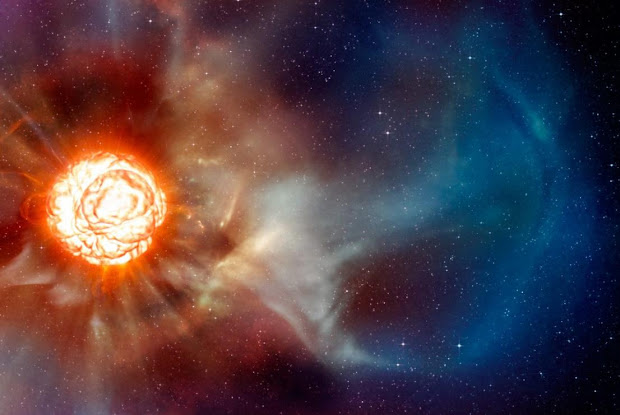Evidence shows that the amount of organic matter buried in sediments and changes in the number of supernovae are closely related. This link has been clear for the last 3.5 billion years, and it has become clearer over the last 500 million years.

Top: A drawing of the Milky Way as seen from Earth, where a supernova speeds up cosmic rays to high speeds. Some of these particles get into the Earth’s atmosphere, where they make structures of secondary particles that look like a shower. Changes in cosmic rays have had an effect on life on Earth, which is a surprising result. (CREDIT: H. Svensmark/DTU Space)
The link between the two things shows that supernovae have made it possible for life to exist on Earth. This is what senior researcher Dr. Henrik Svensmark from DTU Space says in a new article in the scientific journal Geophysical Research Letters.
The article says that one reason for the link between supernovae and life is that supernovae affect the climate on Earth. When there are a lot of supernovae, the climate is cold and there is a big difference in temperature between the equator and the poles. This causes strong winds and mixing of the ocean, both of which are important for getting nutrients to living things. When there are a lot of nutrients, there is more life and more organic matter gets buried in sediments. In a warm climate, the winds are weaker and the oceans don’t mix as much. There are also less nutrients, less bioproductivity, and less decomposition of organic matter.
“A fascinating consequence is that moving organic matter to sediments is indirectly the source of oxygen. Photosynthesis produces oxygen and sugar from light, water and CO2. However, if organic material is not moved into sediments, oxygen and organic matter become CO2 and water. The burial of organic material prevents this reverse reaction. Therefore, supernovae indirectly control oxygen production, and oxygen is the foundation of all complex life,” says author Henrik Svensmark.
In the paper, a measure of the amount of nutrients in the ocean over the last 500 million years has a good correlation with changes in the number of supernovae. Trace elements in pyrite (FeS2, also called fool’s gold), which is found in black shale on the seabed, can be used to measure the amount of nutrients in the oceans. By measuring the ratio of carbon-13 to carbon-12, it is possible to figure out how much organic matter is in sediments. Since life prefers the lighter carbon-12 atom, the amount of biomass in the world’s oceans changes the ratio of carbon-12 to carbon-13 in marine sediments.

“The new evidence points to an extraordinary interconnection between life on Earth and supernovae, mediated by the effect of cosmic rays on clouds and climate,” says Henrik Svensmark.
The connection to weather
Svensmark and his colleagues have shown in previous studies that ions help aerosols form and grow, which changes the amount of cloud fraction. The link between cosmic rays and clouds is important for climate because clouds can control how much sunlight can reach Earth’s surface. Evidence from the real world shows that when the strength of cosmic rays changes, so does the climate on Earth. On geological time scales, the number of supernovae can change by several hundred percent, which can cause big changes in the climate.
“When heavy stars explode, they produce cosmic rays made of elementary particles with enormous energies. Cosmic rays travel to our solar system, and some end their journey by colliding with Earth’s atmosphere. Here, they are responsible for ionizing the atmosphere,” he says.
Note: Materials provided above by Technical University of Denmark. Content may be edited for style and length.